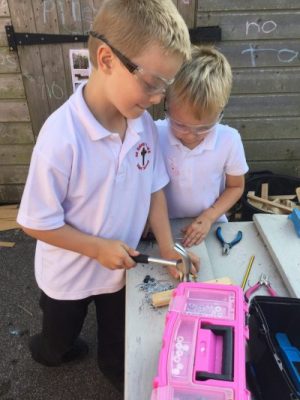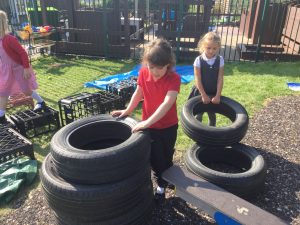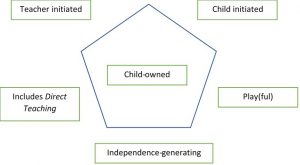
January 14, 2021, by Rupert Knight
Foundation for What? Issues in EYFS continuity and an integrated pedagogy for KS1
In this post, Philip Hood and Joanna Redfern reflect on a journey towards continuity between EYFS and KS1 across two linked C of E Infant schools and offer a model for an integrated pedagogical response.
The problem of continuity
This ‘learning journey’ spans several years. It was first reported on in a journal article (Hood 2013), which reflected an initial phase before the national curriculum changes in 2013; these changes made the KS1 curriculum both more crowded, more formal and more demanding. Since that time the philosophy of the Early Years Foundation Stage (EYFS) has become embedded in the Pre-School and Reception classes, but as children moved into KS1, a dip in both attainment and well-being had become evident. As the curriculum abruptly becomes more formal and adult-centred between EYFS and Y1, the space for children to embed new concepts through play or to explore their own ideas with the support of an interested peer or adult appears to be reduced. Reflecting that, if learning was to be meaningful for children in KS1, it must build on the pedagogy of the EYFS and a sound understanding of child development, a revisiting of the Statutory Framework for the EYFS became the basis of professional development for all staff. But the ‘problem’ remained, as is shown by this statement from that document:
As children grow older, and as their development allows, it is expected that the balance will gradually shift towards more activities led by adults, to help children prepare for more formal learning, ready for Year 1 (DfE 2017:9).
The question then became: What does progression in child-led learning look like as children move into KS1? Is it simply a matter of spending less time on play or other child-led activities, and more on activities led by adults? If what actually happens is more time spent listening to the teacher, then a more sophisticated understanding of the optimum learning environment to deliver KS1 objectives successfully, including the role of the adult, is needed.
A learning journey
On revisiting the article and seeking to evaluate the current position of the schools’ pedagogy and practice, conversations have taken place virtually over the past year between the two authors and other senior staff. Because of the covid-19 crisis, some classroom observation has been mediated by the second author via video technology. Two areas which had been addressed before these discussions with the first author began were the learning environment and the daily routine including a ’plan, do, review’ structure. Support had been received from the Early Excellence Centre and from the local Church of England Dioscesan fund to create both indoor and outdoor continuous provision resources for children to access from choice and to use these creatively. The photos contained in this blog show children engaged in projects they have chosen, working at their own speed and in the way they have chosen according to planning which may have been facilitated by an adult but only in response to their own expressed aims and objectives. They are expected to review each completed piece of work or process task and to speak about how and why they made choices while learning.

Over the past eighteen months agreement has been reached on how much whole-class teaching should occur and what are the daily non-negotiables. Every day KS1 children receive a whole-class phonics/spelling session and an equivalent maths one – each lasting for a maximum of twenty minutes. The other non-negotiable is a daily whole-class story time. Religious Education, Physical Education and guided reading all take place at some point during the week. Beyond this, teachers plan a flexible, creative curriculum which saves time and exploits the links between curriculum areas. For example, the twice a week story time focuses on a PSHE objective through an engaging text that promotes discussion.
Unsurprisingly the ‘terminology’ that appeared and re-appeared early in the discussions were the familiar ones about early childhood education pedagogy: were the activities child initiated or teacher initiated, what was the role of playful activity, should there be a focus on developing independence? The polarity between teacher- and child-initiated activity surfaces frequently in both literature and practice discussions and there was a desire by school staff to see a model where the two were not opposed but complemented each other. The current focus on direct teaching in educational discussion was felt to be a strand which could not be ignored. In trying to see a way which all of these five elements could be held in focus at the same time, rather than in rotation, the concept of child ownership of the curriculum and pedagogy surfaced. If the overall aim of teaching and learning in this (or any) phase is to develop learner agency, then the child has to feel ownership of the school day and of all of the types of teaching and learning it contains. This does not mean the child dictates either the curriculum or the pedagogy, but rather that all learning is child-centred in terms of their active awareness of and engagement in the purpose of all activities, the manner of their participation and their awareness and therefore their ownership of learning.

A pedagogical model
The figure below evolved to be used as a basis for discussing what elements the pedagogical model should consist of and how all of these elements could be made to be meaningful and purposeful to each learner. It is intended, not as a lesson planning model but for a facilitative device to deepen practitioner understanding of how learning might be structured over time and perhaps also as a mode of reflecting back on a learning sequence to unpick how it developed and how it might be enhanced.

Fig 1 An integrated pedagogy for EYFS/KS1 designed to give agency to learners and teachers.
A series of questions attached to each ‘label’ on the diagram was also evolved. The intention of this process was to create prompts for policy discussions from the level of pre-school (a new initiative in the setting since 2013 which includes 2-year olds) through to Y2, i.e. across up to five years of learning. The global aim here is to have a common terms of reference, a continuity and consistency of practice but also encompassing a means to describe development throughout the school. At present these prompts are used to set parameters for the independent learning sections of the timetable but the intention is to refine them into a set which can be applied to those activities/’subjects’ which are conventionally thought to be teacher-led and to contain more transmission-style pedagogies. The key discussion here will be around how children get ownership of sessions where phonics, literacy or mathematics are more directly taught.
Prompts
Child-initiated:
• Does the child start the activity:
o when they decide to?
o in the way they decide to?
o with the resources they choose?
• Is the activity a lone action or undertaken jointly with another child/other children? If with others is there an expressed intention?
Play(ful):
• Does the activity involve spontaneity / creativity (as opposed to a script/formula)?
• Does the activity involve role-playing on the part of the participant/s?
• Does the activity have ‘flow’?
Independence/autonomy:
• Does the child seek:
o adult support
o adult approval
o adult evaluation
Owned by child:
• Does the child continue to regulate the activity entirely independently?
• Is the child unconscious of other activity around them?
• Does the child decide when to end the activity?
• Does the child wish to create a record of the activity?
• Does the child return to the activity at another time?
• Does the activity involve more than one child? If yes, is there a hierarchy of influence / dominance and/or a joint construction/development?
Teacher-initiated:
• Does the teacher choose / set up / suggest the activity?
• Does the teacher choose / suggest the resources / location?
• Does the teacher direct / intervene?
• Does the teacher ‘play’ / ‘work’ in parallel?
• Does the teacher evaluate the activity?
Direct Teaching:
• Is there a need for direct teaching to the whole class / a group / an individual?
• Is the teaching of content or a skill?
• Is the teaching designed to precede major activity undertaken by learners?
• Is the teaching a spontaneous episode prompted by adult observation or learner questioning?
• Is the direct teaching teacher-led (eg an explanation) or dialogic (eg an exploratory discussion)?
It would be great to hear of your thoughts and experiences relating these questions of continuity and integrated pedagogies. Please do leave us a comment.
References:
DfE (2017) Statutory Framework for the Early Years Foundation Stage https://www.foundationyears.org.uk/files/2017/03/EYFS_STATUTORY_FRAMEWORK_2017.pdf accessed 11/12/20
Hood, P. (2013) The development of high-quality interaction and thinking alongside the extension of child-initiated learning into Key Stage One: a whole school initiative, Early Child Development and Care, 183:8, 1181-1196

Good Blog Thank youn for Sharing
This is very interesting, having worked across EYFS and KS1. How would you implement the key skills of writing, would this be done in Phonics? In terms of longer texts … analysis etc, surely if they want to make one they need the skills? Is this done on an individual basis depending on inquiry? How would you find time for this in a class of 30 say?
Thanks Jess – this is Jo’s reply – the project is developing all the time and we enjoy thinking through any issues that arise like this.
There is still a series of short, direct teaching sessions (maybe 15 minutes) to introduce a specific genre and its text and language features. So for example, one session might focus on looking at published versions of the text type and discussing features, another might focus on ‘what a good one looks like’ and yet another could explore the success criteria or modelled writing. Within the day, guided groups can work on composing and developing their own writing whilst other children access continuous provision. After this, opportunities to practice and apply the text type are identified in the continuous provision (for instance, when children present their learning at the end of a project).
We use a similar approach from Foundation through KS1, we are constantly refining the balance between child led and adult initiated/led learning whilst delivering the full KS1 curriculum.
It would be interesting to learn more about the schools that are also doing this – we have struggled to find other settings.